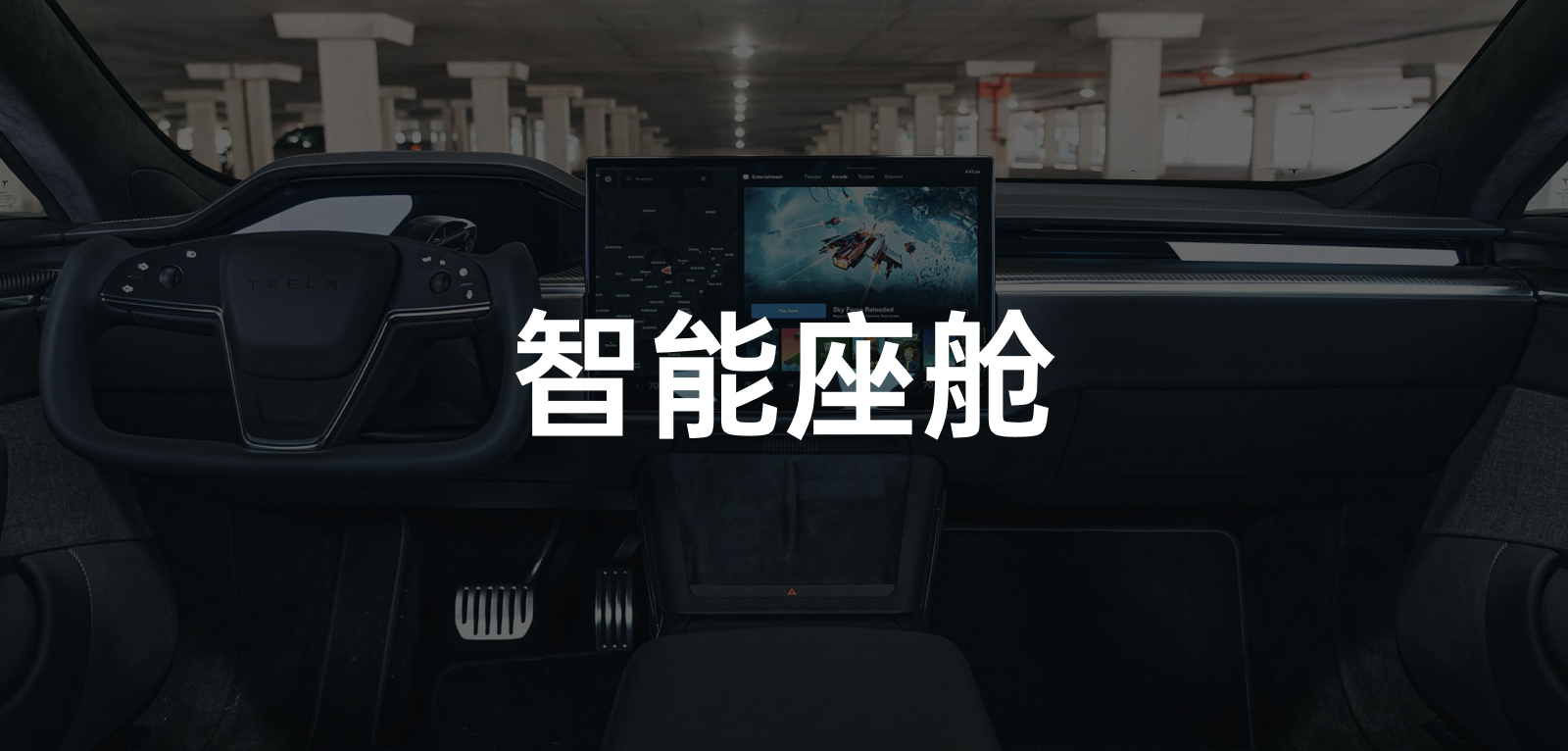The development of new energy vehicles has made great progress in the past decade, especially in the past three years, with the industry now facing the dilemma of “hardware homogenization and software differentiation”, a problem already plaguing the mobile phone industry. The mindset of unrealistic expectations is often manifested in the need for technological accumulation and long production cycles, putting companies under pressure to innovate. After all, most people consider software to be low in cost (“I have a great idea! I just need a programmer!”).
In the past two years, as new platforms and algorithms have gradually been put into use, the “smart cockpit” can finally take a breath from being buried in trending searches. And finally, with the excuse of “not jumping on the bandwagon”, I can explain why I procrastinate and present my opinions on common misconceptions or deviations from the main focus in public evaluations. The most common situation is – “those who understand cars don’t understand software, and those who understand software use templates”.
Cars are evolving from traditional concepts of transportation tools to “an iPad + four wheels”, and gradually becoming electronics-based consumer goods. Whether it is an embedded system, Android modification, Android Auto, CarPlay or any other weird in-vehicle system, it is an operating system based on hardware architecture and capabilities, similar to that of mobile phone systems, smart TV systems, or even smart refrigerators (~~you can even watch videos on the fridge~~).
At the same time, there are differences in consumer behavior, such as differences between buyers and users of children’s watches (parents buy cars for their children), multiple users of Indian phones (several drivers in a family), and the simultaneous use of in-car systems by drivers and passengers, as well as use by enterprises and individuals (~~even the durable Nokia phone can be used as a hammer~~). These differences in usage range from driving, parking, camping, and even sleeping in the car.
 In summary, intelligent cockpit is a comprehensive discipline that has great potential, just like biology in the 21st century. Similar to the erroneous health concept of qigong for all, below are ten common misconceptions in my opinion.
In summary, intelligent cockpit is a comprehensive discipline that has great potential, just like biology in the 21st century. Similar to the erroneous health concept of qigong for all, below are ten common misconceptions in my opinion.
0 “The UI of a certain car’s system is really ugly.”
This statement itself is not a problem, as design and aesthetics vary from person to person, and there is a popular consensus under current trend. But the discussion of this viewpoint often only stays at the level of interface icons, failing to discover deeper problems behind it.
After XPeng G9 was criticized and modified its pricing the same night, it was criticized again for refreshing the exhibition car software version overnight with a new UI. Most of the comments were “so ugly” or “so low”. The icon colors are extremely rich, the two-dimensional and three-dimensional are fully expressed, and various gradients are used boldly. If you look closer, you will find that it is not only ugly, but the bigger problem is: messy.
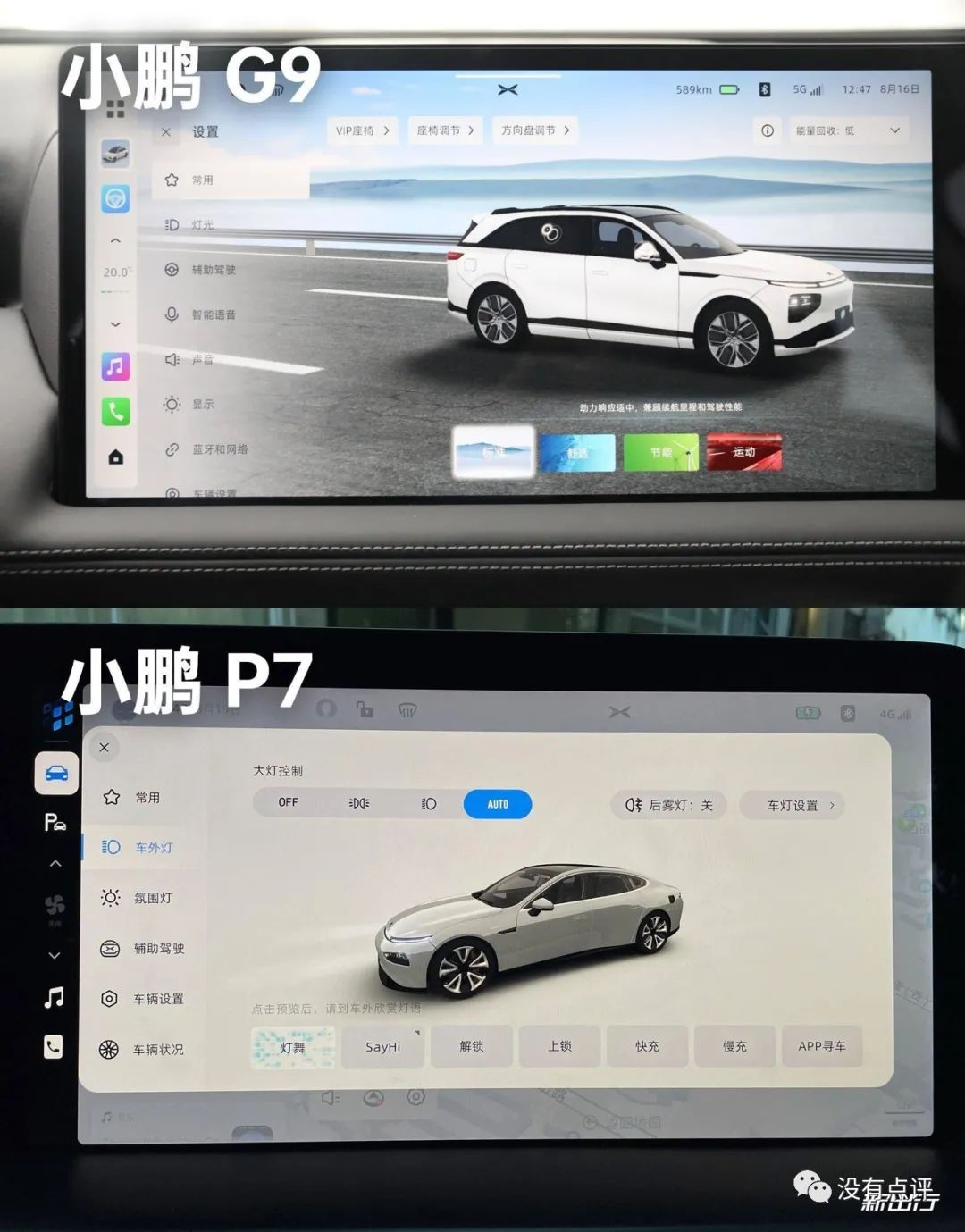
Icons with too many colors will blur the focus of the interface, reduce the efficiency of quickly finding functions or operations, especially when all the central screens of the car system are maps. Fortunately, I experienced it on an emergency-refreshed exhibition car.
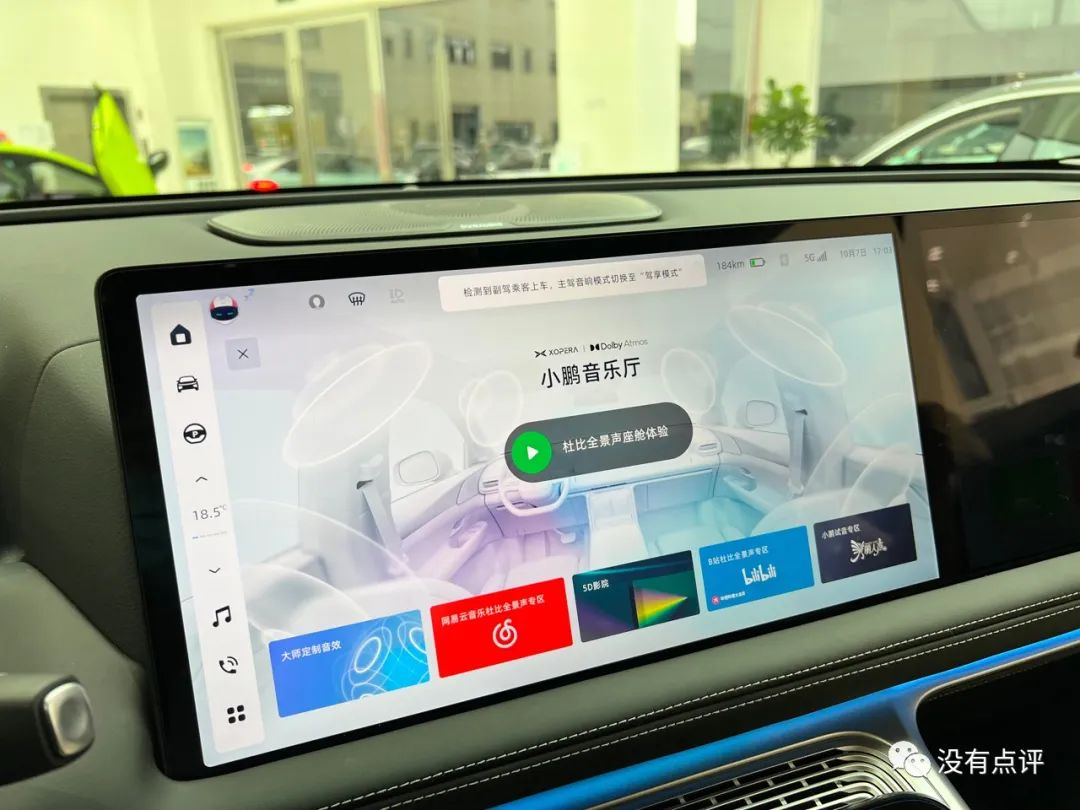
The information layout in all directions is relatively random, which gives the impression that anywhere can have an icon and a line of text can be stuck on it, filling the screen pixels. Then, the readability of the status bar is reduced.
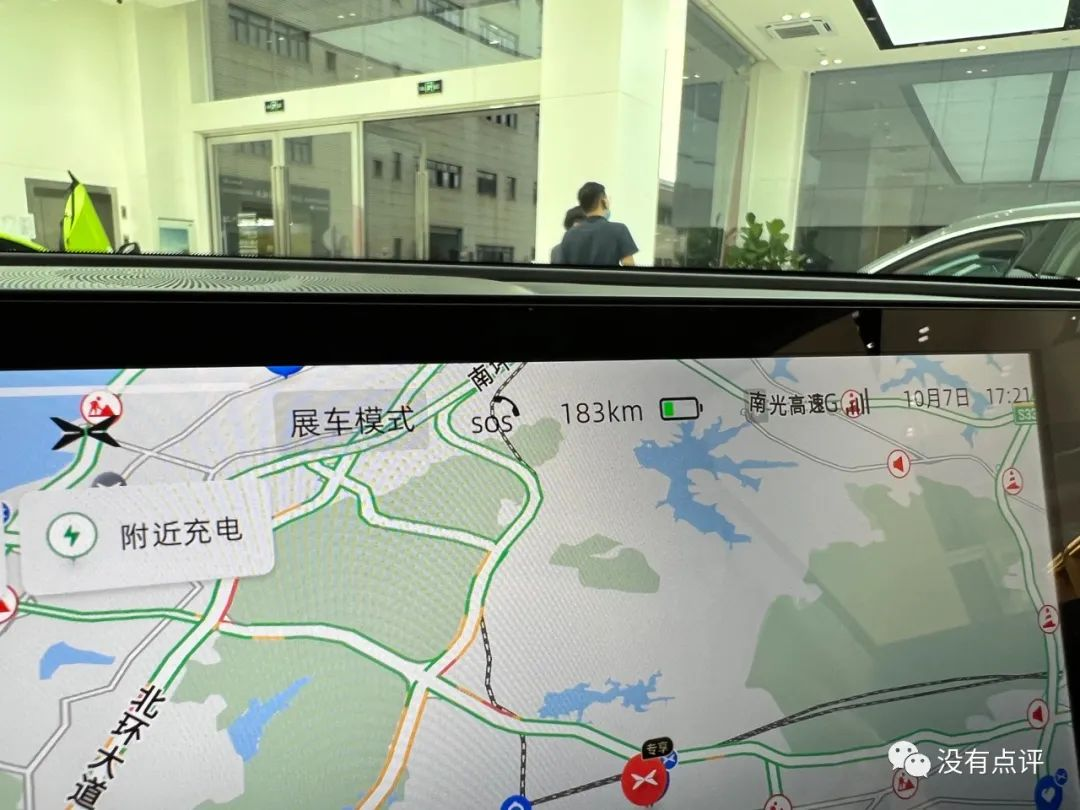
The dock bar, quick cards, and application list have almost no customization capabilities. It is unclear how to meet users’ personal usage preferences, as well as the reliability of blind operation in mobile scenes.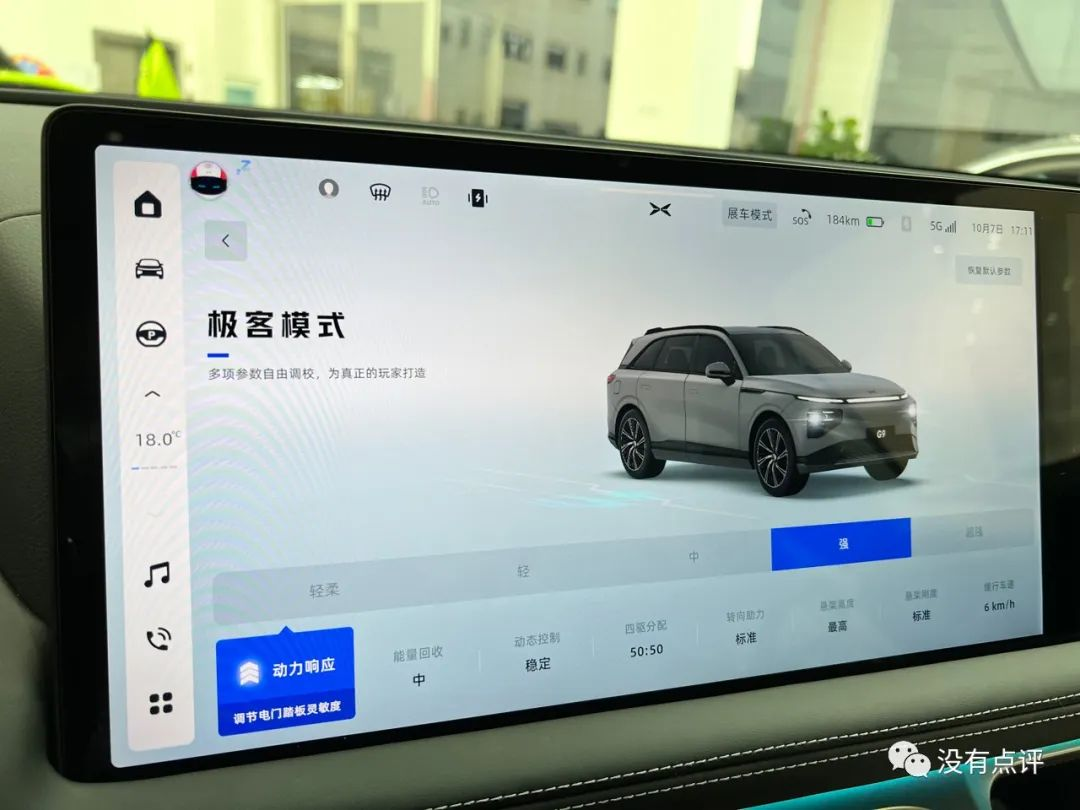
The interaction definitions across different interfaces seem to have been pieced together by different design teams, even for different functions within the same module and interface, like a makeshift blended family. Users cannot familiarize themselves with the overall interaction framework on commonly used pages, so they have to learn the information layout and interaction methods of the current page each time they switch to a new one, even within the same module.
It seems that XP has developed many small applications without anyone being responsible for thinking and building a complete system. They may not even realize that this is a problem.
(About the XP redesign this time, I could write tens of thousands of words… I have found a bunch of problems in just 10 minutes of experience~~ I need a car~~)
I am not sure whether this system can cover G3, P5, P7, G9. Although changing the car within the same brand or buying an additional one is not the mainstream, the consistency across all series models is a long-term issue that needs to be addressed, as it can reduce the media and user learning costs, as well as the software team’s maintenance costs.
Consistency also brings up a higher-level issue: Do you have an impression of the brand color or brand elements of XPeng? The design language of the software system is an extension of the brand’s design language. In the new energy vehicle field, which pays attention to exterior design, interior design, promotional materials, and direct stores, the coherence of brand design needs to be emphasized more.
(~~XPeng may be the best company in China in this regard, because it has been criticized by car owners the most in the past.~~)
1 “Built-in nap mode, queens mode, camping mode, health mode, and other intelligent services!”# Tesla rolls out pet mode and camping mode led by popular Twitter bot Ma Yilong, highlighting the distinct differences between new energy cars and traditional automobiles. The “rest mode” led by Sun Jijiji, who has now switched to off-road motorcycles, received great praise when it was first launched on the “Daddy’s Car One”. The company belongs to the boss, the home belongs to the child, and only the time to smoke in the parking lot belongs to oneself. Since then, domestic new energy car companies have been frantically adding various “one-click XX modes” to their in-car systems.
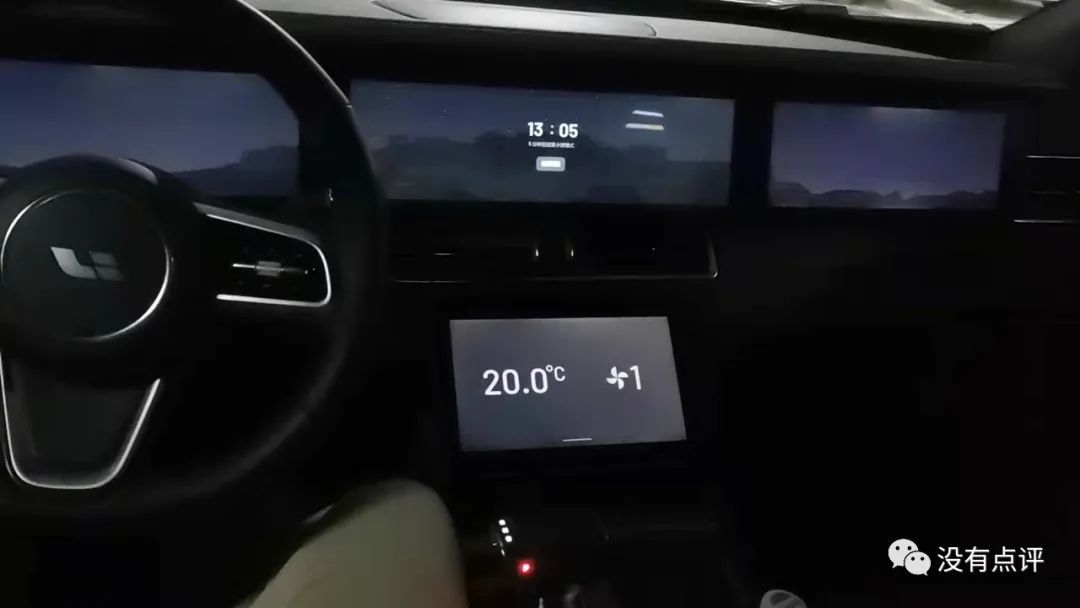
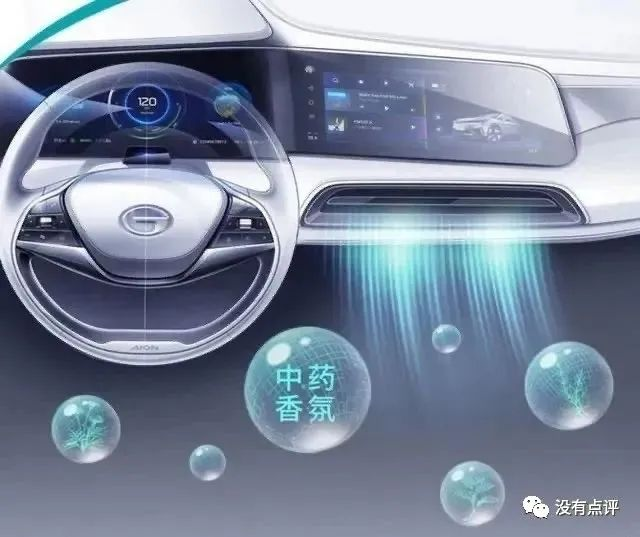
Using modes to introduce functions specific to certain scenarios has obvious advantages. Firstly, it can create usage scenarios, guiding users to imagine and use “cars and homes” in more ways; secondly, it can reduce cognitive costs, clearly describing where to use and how to use in just a few words; finally, clear scenarios and usage methods can naturally be transformed into selling points in advertising.
However, could it be a response strategy for product managers who are too lazy to think or are pressured by the market to create product features? The important question is: Is this what users really need in terms of usage scenarios? Are we complicating the solution by combining functions?
Is it possible that what users need is just quick access, but what BYD gives is highly customizable gesture control feature? Or it is possible that users just want a high-pitched, sweet and low-pitched audio system, but XP provides 5D air conditioning and butt poke function? Or is it possible that the co-pilot goddess needs a suspension system that can stabilize the car body and lipstick without going beyond the lines, instead of a beauty mode that changes the color of the lights?
2 “TVs, refrigerators, and large sofas, co-pilot queen matches makeup, baby seats with small table tops to meet the needs of different people.”New energy vehicles can break the simple classification of passenger cars and commercial vehicles (can sports cars even count as cars?), and start to focus on the driving experience of passengers other than the driver and different from the role of a boss. This is absolutely a genuine concern for consumers.
Under the leadership of product managers who know the most about cars, media, and user experience (yes, it’s Mr. Bai and the Captain), the first two vehicles (one counts as the first model, and L9/L7/L8 counts as another model) are accurately targeted towards the “dad” group. From this perspective, I would like to call it the real Xiaomi of the automotive industry. Therefore, the ideal functional design can perfectly address the needs of middle-aged men and their families with a wife who loves variety shows, a game console that you love, a small desk for your child to do the homework, and a thermos fridge for the milk bottle! However, what about grandparents and great-grandparents? TOF is good, but learning and memory are too difficult for the elderly.
The ideal strategy is successful, but it cannot be copied directly. As more sedan and pure electric models are introduced, I believe they will have different definitions. Different car companies and their different vehicle models are undoubtedly targeting different user groups, including singles, women, parents, grandparents, one person, two people, a group of people, and so on. Can outstanding answers from the National A Exam be used to fill in the answer sheet for the National B Exam to achieve good results?
Is it possible that internal cameras, seat sensors, and UWB can help identify who the primary driver is, who the passenger is, whether there is anyone in the back seat, and who is in the back seat? In addition to multiple accounts on the APP (which some car companies are still not doing well), knowing the identity of the passengers and providing corresponding software and hardware services in advance is also essential.To be honest, I think many car companies are milking the success of the FF91. Although Jia Yueting may not be good at making cars, he knows how to cater to the tastes and demands of wealthy individuals so well that a single PPT presentation can generate so many innovative car models. Take the queen’s ride, for example, with its multiple passenger identification, independent audio environments between different seats, and the ability to transfer app functions between mobile phones and car screens (~~I’ll start a ZOOM meeting in the car first~~).

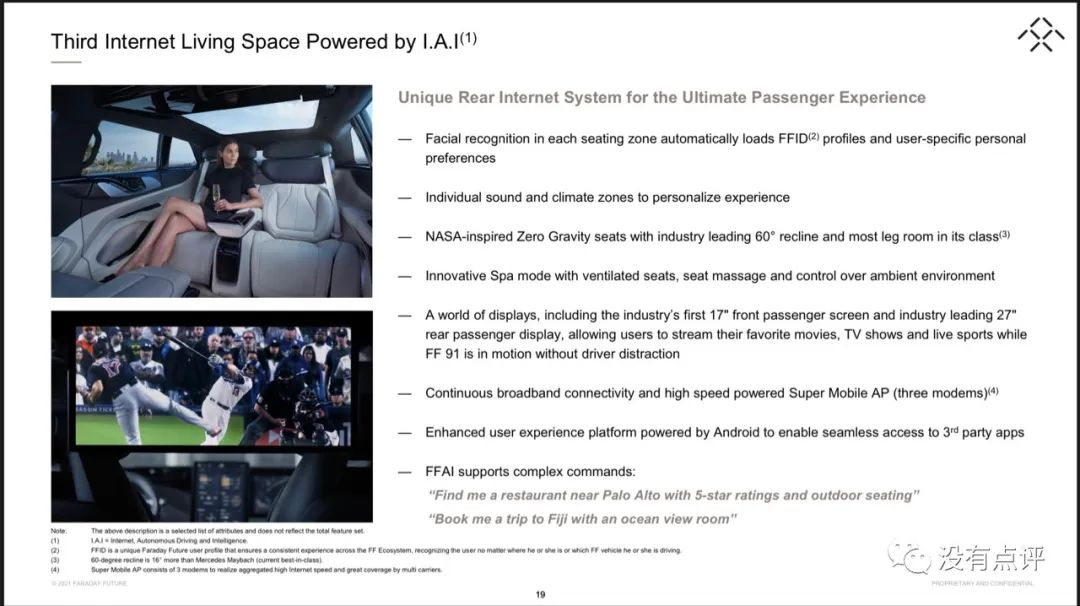
3 “Longer screens, more screens, more technology!”
I don’t know when it happened, but the size and resolution of car screens have become a key parameter. Do I need a 300,000 yuan car instead of a computer or iPad for my next step? From the center console screen to the entertainment secondary screen, to the touch screen in the rear seat, to the latest ceiling big TV. While people complain that entertainment apps are taking up more and more of their fragmented time, they are also filling every corner of the new car interior with screens that can be used to watch talk shows or TikToks.
And what’s inside the screens? It doesn’t matter. What about the multi-tasking and audio channel processing after launching several screens? It doesn’t matter. What about the control relationship of the content on each screen? It doesn’t matter. Let’s just make the golden spoon first, and it doesn’t matter what we use it to eat. Using a golden spoon to eat shit is still shit. Foldable phones have been around for so many years, but the majority of app adaptations are still terrible, let alone in-car screens with various resolutions and bizarre display area constraints (~~not to curse NIO’s vertical screens~~).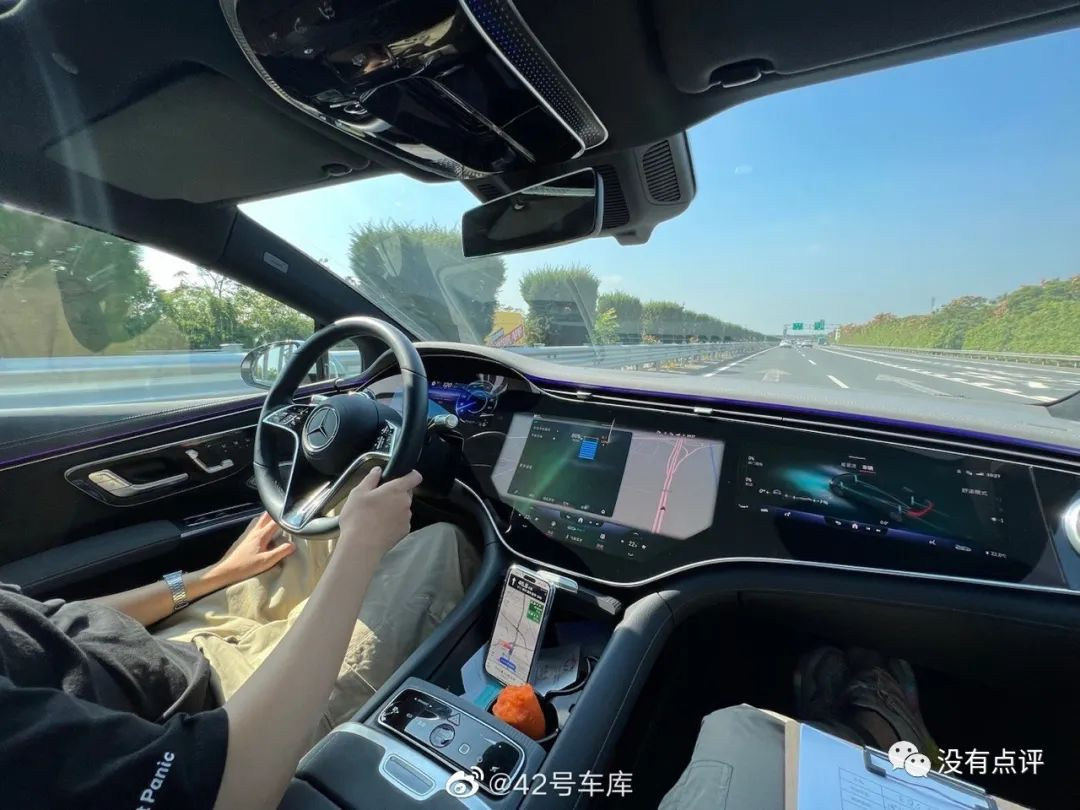
Why should LeEco make cars? People on the internet made fun of LeEco’s 30-second ads at startup. Adding big TV ads hasn’t changed the commercial model for video distribution, but it made Weibo users excited? In order to solve the problem of controlling the big TV in the back row, the Ideal L9 is equipped with TOF, and the JiKe 009 is equipped with a remote control. It is boldly speculated that there will be product managers full of spirituality in the future, adding touch pens to the co-pilot or rear screen for children’s creativity.
Car companies hope that users will stay in the car more, or at least turn on the car’s screen and air conditioning in idle time to increase the user’s usage time. But with multiple screens, can two people watching Douyin make users feel like they’re in a living room? Do they hope users will have a mobile living room lifestyle once they leave the parking lot? Does this still count as home, Jonny? According to this theory, Xpeng is the perfect answer to “car and home”, with both a car and a house, and the option to purchase parking spaces.
4 “Zoom in, zoom out, drag, swipe, rotate, how smooth it is! Great!”
Just like screen parameters, chip models are also points that various companies like to boast about. Unfortunately, except for the not-yet-in-production 8295, there is currently nothing but the question of whether it’s one or two 8155 chips. Based on Qualcomm’s outstanding performance in mobile chips over the years, I blindly speculate that the debut manufacturer of the 8295 will have a catastrophic performance, and according to the order of brags, it will be the first car in the metaverse – Jidu Robo-01!When evaluating the performance of chips in the automotive industry, experts often use a simple and intuitive method – smoothness of operation. This smoothness can be directly observed by the eye or captured by a camera, rather than being quantitatively measured by frame rates. This is because basic system capabilities relevant to screen response, processing speed, rendering speed, throughput efficiency, network connectivity, and more can be demonstrated using the simplest methods. However, with the prevalence of traditional automotive systems that are dependent on suboptimal PPT presentations, it is unclear whether these capabilities can be better represented in a more advanced way. At least G9 had the courage to try 3D UI, although the results are unknown as a full landing-version wasn’t seen yet.
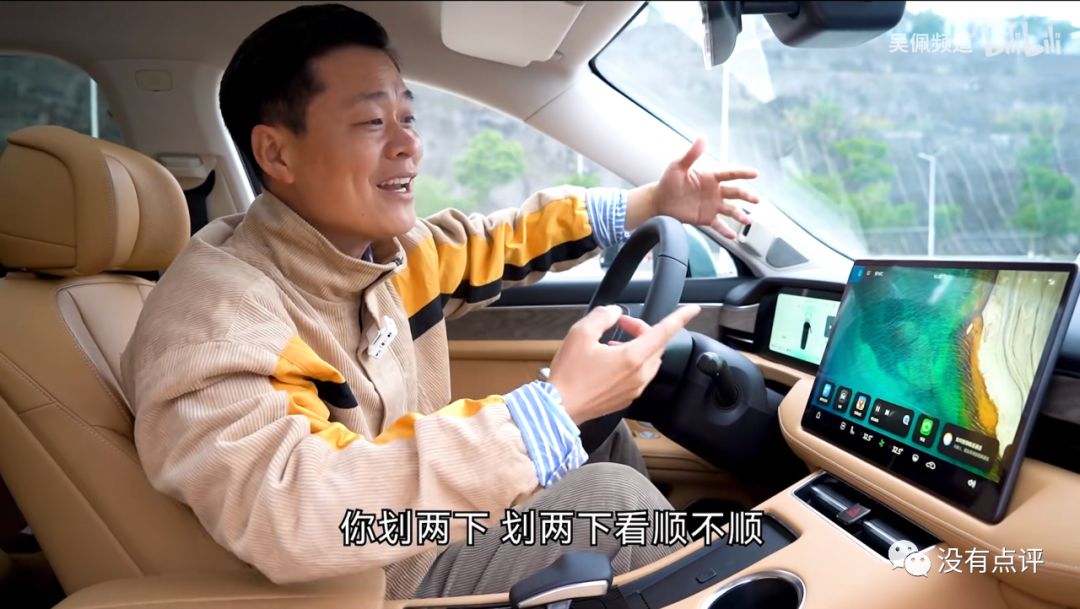
With its strong foundation in the smartphone industry, Huawei can use its own HiSilicon Kirin 990A chip, and its software-hardware integration research and development capabilities are incomparable to other manufacturers. Tesla also boasts “AMD, yes!” and has put Intel on ice. However, the full potential of chip capabilities has yet to be exploited, and there is still no standardized answer for chips that support in-vehicle systems.
Chips for assisted driving modules are similarly limited – which manufacturer doesn’t use dual Orin X, only to claim the current flagship model? Multiple manufacturers are available as choices, such as Mobileye, Horizon Robotics, NVIDIA, and others, creating a benign competitive environment. Nonetheless, I still can’t really understand why carmakers insist on developing their own chips at the bottom-level logic, aside from preventing supply chain crises caused by international policy changes. If you want to wade into this murky water, you have to go to the uppermost stream to seek a breakthrough.
5. “Comes with an app store, and can download a vast number of applications.”I really like a sentence from a review of a Pacific Automotive test on the BYD Han: “With 183 apps, BYD Han kills all its competitors!” The adaptation to Android tablets and the 183 apps reflect the huge efforts of business and research and development.
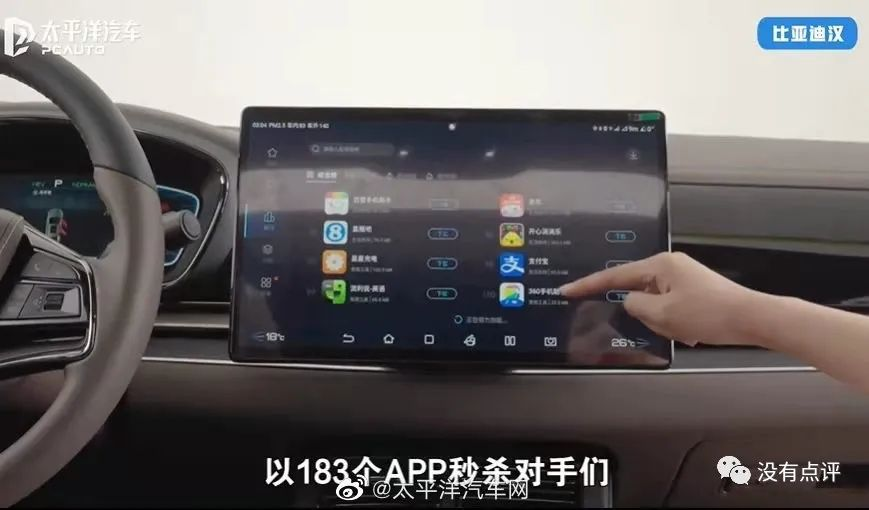
On ordinary models, the number of apps is relatively low. Especially on cars with more screens and stranger shapes, the number of apps will be much less. Because most car companies do not directly use only Android (~~guess why~~), for software applications/service platforms, every new car company, even a new model, needs to invest certain manpower to develop and adapt. The investment of software applications/service platforms is mainly in this area, as well as in subsequent functional maintenance. What are the benefits? Firstly, the addition of new users, with a delivery price of 100,000 yuan per car (currently), which is already quite high, and 100,000 yuan is just a drop in the bucket for the Internet platform. Secondly, income, if users use the service in the car, it may provide longer duration or better membership, and subscription conversion, which still has some value. Overall, car companies need to reduce the difficulty of adaptation, find high-value cooperation scenarios, and have rich software service cooperation. Capital strength is also good, and the market size is large enough, so car companies are wealthy.
Tesla’s shady approach uses web pages to host applications, and the experience is somewhat shady, but it can still be used. The most ideal situation is to copy a set of WeChat mini-programs’ ecosystem within the car’s system. BMW and Tencent also have similar technical solutions, and Huawei is also migrating its smartphone lightweight application solution to car systems. However, the possibility of apps getting massively improved is relatively low, and the reasons need to be traced back to users’ usage scenarios and needs analysis.Before, users enjoyed CarPlay, which allowed them to access their favorite maps and music apps on their phones. Now, in the car, people can watch Tencent Video, iQiyi, play games, and sip tea. The extended entertainment functions include multimedia and gaming. Whether a mobile living room, a “car and home,” or just a living room, it is no different from entertainment, learning, and work. Entertainment is expanding, and Jia Yueting fantasizes about people having Zoom meetings in the back seat, so Chinese elementary school students, please expect good things to happen! So, do you know what applications are available on the rear TV?
6 “This car can connect to a controller, microphone, watch, as well as home speakers, locks, and water purifiers!”
There were three classic entertainment scenes that once made people go wild in the car: being able to connect a microphone and sing karaoke in the car, regardless of the poor acoustics —— wow! Being able to connect a game controller, even though there weren’t many games to play —— wow! Being able to connect a game console, can you believe someone would bring their Xbox fridge into the car? (When this article was half-written, I saw that Mr. Rou was really playing Witcher in his L9) —— wow! Currently, the main reviewers of cars online are middle-aged men who are still optimistic and enjoy modest DIY innovations. The services that cars can provide are limited, and extra services require more money, and the most economical way to provide content is to reuse screen casting, which can also provide users with the convenience of on-demand use. The success of entertainment interoperability is a win-win situation for partners, car manufacturers, and users.
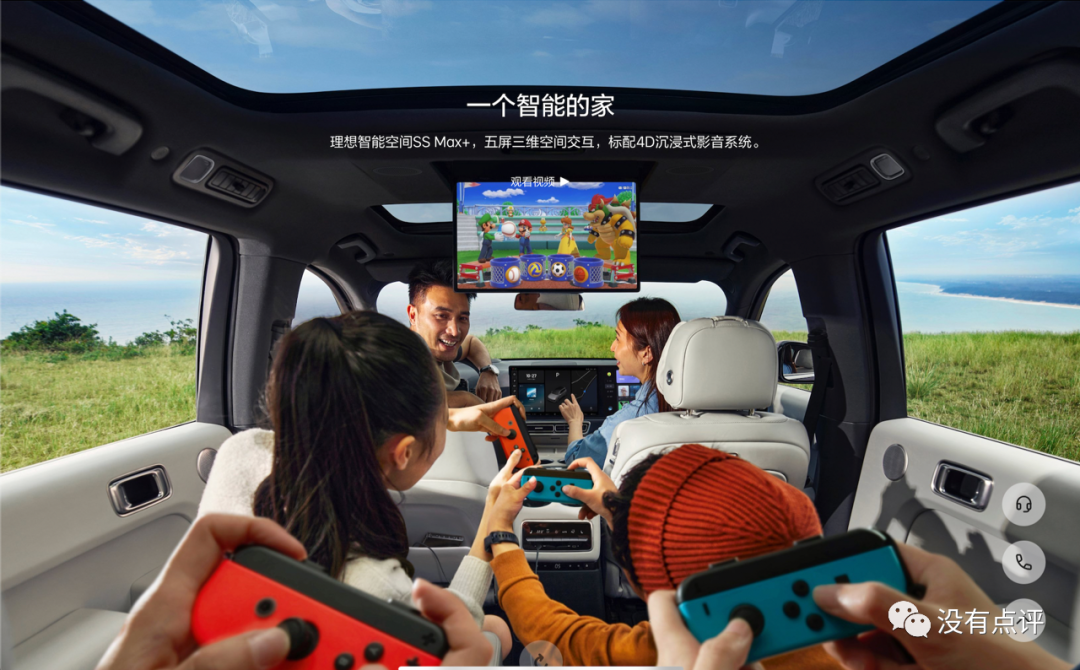 Other directions of interconnection between different industries are not so reasonable. One approach is to completely copy the role of the mobile phone, similar to ancient arranged marriages: “Through the voice and touch interaction on the car console, the owner can turn on the air conditioner, air purifier, and electric water heater in advance while commuting from work.” In fact, even with Level 2 driving, can’t the voice assistant on the mobile phone also perform these operations? Another approach is to partially copy the role of the mobile phone because there is no better alternative way of use. When the ID.6 car leaves a certain range, the home door lock will be closed, and when the ID.6 enters a certain range, the air conditioner will turn on in advance. Users cannot leave their phones at home just because they have a car, right?
Other directions of interconnection between different industries are not so reasonable. One approach is to completely copy the role of the mobile phone, similar to ancient arranged marriages: “Through the voice and touch interaction on the car console, the owner can turn on the air conditioner, air purifier, and electric water heater in advance while commuting from work.” In fact, even with Level 2 driving, can’t the voice assistant on the mobile phone also perform these operations? Another approach is to partially copy the role of the mobile phone because there is no better alternative way of use. When the ID.6 car leaves a certain range, the home door lock will be closed, and when the ID.6 enters a certain range, the air conditioner will turn on in advance. Users cannot leave their phones at home just because they have a car, right?
The concept or dream of everything connected comes from the mobile phone industry. Mobile phones are currently the center of human information processing. Starting from here, they understand or misunderstand users and then connect more IoT devices to provide front-end services. Huawei’s “1+8+N”, “1” is a mobile phone, “8” includes “TVs, computers, watches, earphones, speakers, tablets, glasses, and car consoles”. The car is not and will not be the primary information processing center for people in the short or long term. The primary information processing center for human beings must be able to operate closely with them anytime, anywhere. The car is only the only center for the driver during a certain period of time, and the co-driver can even continue to lie down and play with their phones. Therefore, the pie of interconnection should not be too large. The enhancement of information processing capabilities of the vehicle by NIO’s mobile phone to better serve the vehicle connection does have some logic (although not much).
If someone insists on talking about RVs, then you can go and stand guard at the highway junctions.
7 “Hello, Xiao X… … … … … … . Everyone is operating, amazing!”
The voice assistant is a suitable interaction method for use in the car. Xiao Peng’s voice assistant also has the ability to recognize and respond to different positions in the car, providing a reliable and efficient interaction mode in scenarios where screen and button operations are inconvenient. For ideal car owners, it is also common to have several elderly people and children in the car, and voice input is a more accessible interaction method for them. (Who doesn’t like Peppa Pig?)Since a long time ago, evaluators and in-car voice assistants have been demonstrating their ability to engage in friendly conversational exchanges resembling those between children and smart speakers like Xiaoai. For instance, evaluators can say a series of over a dozen operational instructions that normal people couldn’t possibly remember without referencing a script, all while waiting patiently for the car to execute them within a couple of minutes. Or evaluators could say an apparently lunar address and then demonstrate how the car can navigate to it. At first glance, it all seems like an amazing feat of technology. However, upon reflection, it may appear that these abilities are too powerful to be skillfully controlled.

The reason why voice assistants are now more convenient to use in cars is not because of significant technological advancements, but rather because most car companies have blindly followed Tesla’s lead and removed all operational buttons from their cars. At the same time, they have failed to build a relatively stable and efficient control panel on the car’s display. All evaluation videos use standard Mandarin Chinese, targeting the large Chinese market. But what about other dialects, such as Cantonese, Sichuanese, Hunanese, Hebei dialect, Fujianese, and so on? Even if Nio and Li Auto (ranked by market value) claim to be going global, being able to handle English is just a basic requirement. If they start from Norway, how about Norwegian? Sweden has already had stores, what about Swedish? The internationalization of voice assistants may not necessarily advance in a continuously leading technological direction.
8 “Who would be bored enough to change the voice assistant’s outfit, skin, or hat?”
Personalization is an eternal demand. A bunch of people not only spend money on paint color when ordering a car, but also carefully select color film, decorate the license plate frame with a ring of broken diamonds, and put cute Pop Mart bubble toys on the front windshield. Some big and little kids stick “Press F to enter” and “Autopilot activated” stickers on the windshield and on the back of the car. The fastidious people from Chaoshan might put a fan on the air conditioning vent, raise a bonsai with a fake rockery and water circulation, and put a kung fu tea set in the rear seat. Horsepower +50 would be even better.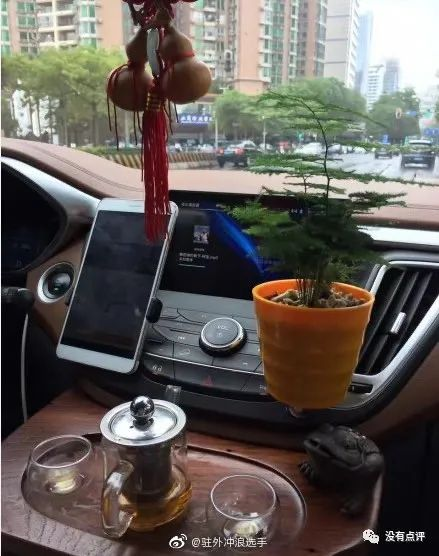
This also explains why NIO owners love to give NOMI a makeover. Besides expressing love for the baldy, it also highlights the owner’s lifestyle taste. Tesla’s limited lighting conditions are maxed out by owners, coupled with popular TikTok songs that light up the cabin like a night club (~~not as eye-catching as the Y clothesline-like roof rack though~~). XPeng’s welcoming sound effect, which sounds like the Windows startup sound, echoes across the parking lot and surprises onlookers. The car’s aroma is also carefully selected, knowing that everyone is exhausted after work and would love to have a variety of essential oil scents from a SPA store. There are also high-end cases, such as Mercedes-Benz’s cool ambient lighting that requires an additional fee, which looks very high-end, especially when contrasted with the three-pointed star.
After all, adjusting hardware requires a certain amount of investment, but software skinning is more affordable. Tesla, a well-known international skinning company comparable to domestic skinning factories, provides visual car models and route skins, which is favored by many ladies. After expanding the China team, the first function to customize car model colors was launched, which was deeply loved by many guys. Wallpapers, themes, icon packs, virtual assistant images, voice assistant voice packs, car models, road condition displays, car audio effects, acceleration sound effects, incoming call ringtones, notification ringtones… just thinking about them makes me excited and look forward to Mr. Lei’s car.
9 “Zhou Hongyi comes to sell anxiety again. Can a car with 360 antivirus software installed achieve full marks for information security and prevent spontaneous combustion?”
After investing in NETA, Mr. Zhou Hongyi’s Weibo about the safety of new energy vehicles attracted much attention, and most of the netizens followed with amusement. When it comes to the safety of new players, most people think of the visually stunning car accidents and spontaneous combustion incidents that are accompanied by the smell of blood. However, even if users were merely watching from the sidelines, the field of safety requires experts, and the red dress chief is an expert who knows what he’s talking about. The car’s ability to assist drivers is becoming increasingly stronger, meaning that the software is gaining more and more control from human beings, and software invasions have long ceased to be a novelty. At the same time, regardless of whether it is for providing keyless entry, remote control, or OTA, the connectivity is far richer than that of traditional cars, and the cellular network, NFC, Wi-Fi, Bluetooth, and so on can all be used as entry points. Imagine for a moment that the neighbor, Mr. Wang, unlocked your car with his Wi-Fi hotspot in the middle of the night, and then drove it to the police station with the assistance of the GPS navigation system, and opened the windows and doors, playing “Peppa Pig” at a maximum volume for the whole night.
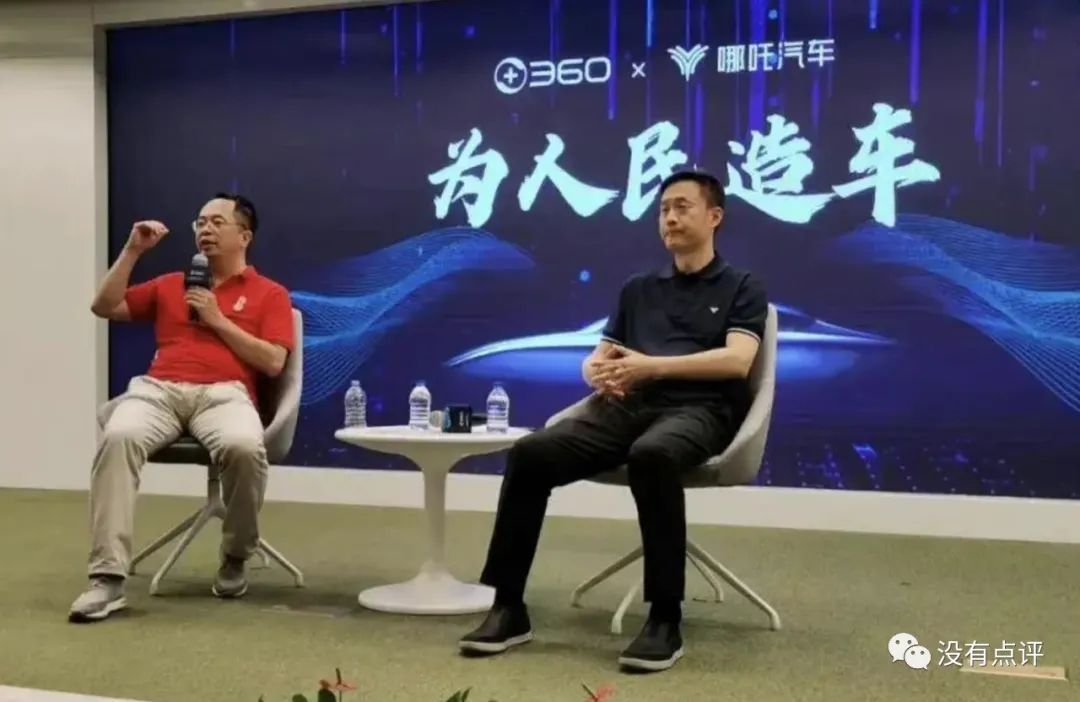
The safety mentioned above is perceptible to users. Data security after uploading to the cloud, on the other hand, is a much more serious issue. In recent years, it is not uncommon for various companies to have their databases stolen (~~my apologies for the poor humor~~), which means that the stored user data has been copied by malicious individuals. Generally speaking, these data breaches typically include user accounts (phone numbers, email addresses, etc.), personal information (age, gender, height, etc.), and even more private information (phone models, car models, identity card numbers, passwords, bank card numbers, etc.).# Dedicated to international development, auto companies need to meet the requirements of different regions’ data privacy laws and create global service capabilities, as well as meet local compliance requirements in different markets. Compliance is a comprehensive issue that includes specific legal and regulatory requirements (such as the position of car control icons and preferred language settings) as well as non-industry mandatory requirements (such as regions that can be selected from national and regional lists and local standard maps). It even includes the universal concept challenges brought by increasingly complex Western social values and public opinion, such as binary gender issues and model body image anxiety.
Last, but not least.
The above discussion is separate from the major issues of vehicle positioning, BOM and pricing, sales strategies and SOP, technological reserves, and development trends. In practice, it is impossible for all products to be handled independently, but rather they must be interconnected and constrained from top to bottom. The ultimate issue of the intelligent cockpit is whether there is a set of skills that can be used on any battlefield, with any weapon, and against any opponent, and still emerge victorious?
The intelligent cockpit has a rich variety of use cases, continuously updated hardware and software, and a clear market space for growth. The industry standard answer for software and hardware architecture is still being explored and will eventually be achieved through attempts and debates. This answer will be closely related to another classic question: “Will there only be three new power companies in the future, or will there be many companies competing at different price points?” As a consumer who has experienced the Windows era of computers and the iOS VS Android era of smartphones, I would prefer to have more competitors providing services and I am also concerned about the inevitable monopolization of oligarchs.The following are several dimensions abstracted from the current development stage that may apply to the intelligent cockpit: sufficient information acquisition and focused information display, stable interactive operation and expected response, accurate user identification and automated system services, software and hardware ecology that can meet major needs with good horizontal compatibility, personalized ability to meet emotional appeals, excellent basic performance and safety. Then, value positioning is conducted from two dimensions of user purchase motivation and usage stickiness, which roughly forms a more universal analysis framework.
The development of things conforms to the objective physical rules, rising in a spiral until the emergence, update, and replacement of industry standard templates. Whether the cars in ten years will still be in their current physical form is questionable, and all the issues currently under discussion may be wrong (~~I’m getting confused here, so this paragraph is all gibberish~~).
This article is a translation by ChatGPT of a Chinese report from 42HOW. If you have any questions about it, please email bd@42how.com.
